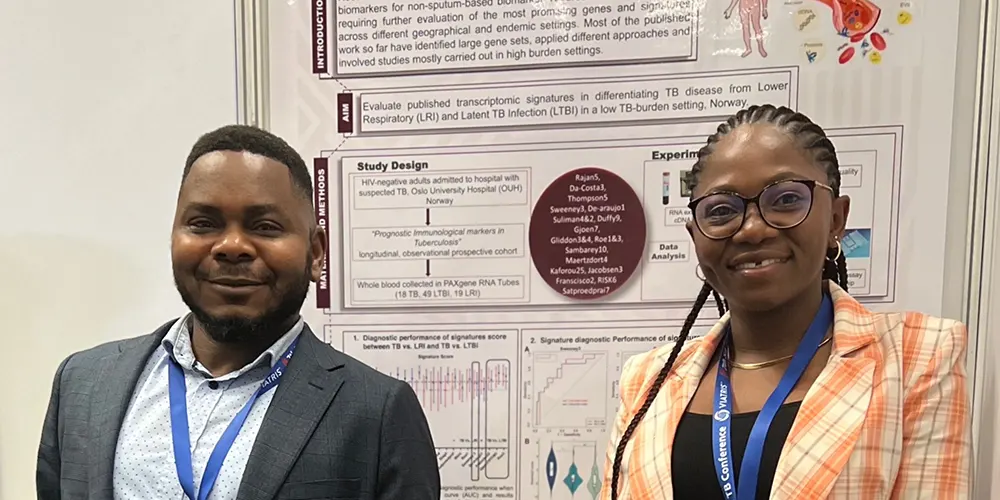Rapid diagnosis and treatment are crucial in the fight against tuberculosis. But today's testing methods are not good enough. Tests based on blood biomarkers may be the solution.

The study is a result of a collaboration between the University of Oslo and Stellenbosch University in South Africa. "The comparison between patients in South Africa and Norway made it possible to examine blood samples from people with different backgrounds and who are infected by the Mycobacterium tuberculosis in different parts of the world", researcher Bih Hycenta Chendi (right) says. Here together with Professor Anne Ma Dyrhol-Riise (left) after receiving her doctoral degree at UiO in 2022. Image: private
Many of us believe that tuberculosis has been eradicated, but this is not the case. In large parts of the world, tuberculosis is the infectious disease that takes most lives.
Every year, 1.5 million people die from tuberculosis, according to the World Health Organization (WHO). South Africa is one of the countries that are most affected.
During the covid-19 pandemic, the situation became even worse. Even more, people fell ill and died of tuberculosis due to the lockdown and poorer access to health care.
Urgent need for rapid diagnosis and treatment
In the same way as with covid-19, early and rapid testing and treatment are important both for those who are ill and to prevent the sick from infecting others.
"With the increase in the number of disease cases and deaths during the covid-19 pandemic, we cannot stress the need for early, fast and accurate diagnosis enough", Bih Hycenta Chendi says.
She is a researcher at Stellenbosch University in South Africa where she works with Professor Novel Chegou. They collaborate with Professor Anne Ma Dyrhol-Riise at the Institute of Clinical Medicine at the University of Oslo.
Several challenges with today's tuberculosis tests
Tuberculosis is caused by a bacterium called Mycobacterium tuberculosis. The reference tuberculosis test is based on bacterial culture. Health personnel take samples of the patient's sputum to find out if it contains the bacteria.
"There are several challenges with today's tests. One of them is that it takes a long time to get the result. In addition, they are not that sensitive and accurate", Chendi explains.
"Especially in areas with poor infrastructure, such as several areas in South Africa, there is a great need for new ways of detecting tuberculosis", the researcher adds.
Have found a new way to test for tuberculosis
Chendi and colleagues work to find new and better testing methods. In a new study, they have found that some substances in the blood can show whether a person has tuberculosis.
Such substances are called biomarkers.
The biomarkers refer to any measurable biological component in the blood that reflects ongoing immune processes in the body at a particular state.
"We now know more about how the immune system reacts to a tuberculosis infection. This is the reason that some researchers have suggested that these biomarkers may be used to diagnose tuberculosis", Chendi explains.

Could detect tuberculosis based on a blood sample
The researchers analysed blood samples to see if the various already identified biomarkers could be used to diagnose tuberculosis in a setting like Norway where the prevalence of tuberculosis is low.
"Most of the biomarkers that we looked at could detect with good accuracy whether a person had tuberculosis", Chendi says.
She explains that this matches what other researchers have found in previous studies.
In addition, Chendi and colleagues looked at combinations of different biomarkers.
"Compared to a single biomarker, the combinations of different biomarkers performed even better", she says.
The tests can be used to monitor treatment response
Patients with tuberculosis are often seriously ill and hospitalised. The treatment consists of a long antibiotic cure where the aim is to defeat the infection.
In the study, the researchers looked at whether the biomarkers could be used to monitor the effect of the treatment.
"We saw that the concentration of some of the biomarkers in the blood changed from the time of treatment initiation and when evaluated at week two, month two and month six of treatment, highlighting their usefulness in monitoring treatment response", Chendi explains.
New tests can reduce the number of unknown cases
The researchers believe that new and better tuberculosis tests may be developed based on the biomarkers examined in the study.
"The results from our study are promising. They show that the biomarkers we investigated have good diagnostic value for tuberculosis", she says.
Especially in areas that are badly affected by the disease and that have poor infrastructure, such new tests may be of great importance.
"Such a tool will ensure that we can make the diagnosis quickly and easily. It can also help reduce the number of undiagnosed cases and those affected can receive faster treatment. In particular, the gains will be large in African environments with few resources", the researcher says.

Examined blood samples from people in South Africa and Norway
The study is a collaboration between researchers from the Immunology Research Group at Stellenbosch University and the Chronic Infectious Diseases research group at UiO and Oslo University Hospital (OUS).
The researchers examined blood samples from 107 people with tuberculosis, 78 people with other lung infection and 150 people without tuberculosis in both South Africa and Norway.
"The comparison between patients in South Africa and Norway made it possible to examine blood samples from people with different backgrounds and who are infected by the Mycobacterium tuberculosis in different parts of the world", Chendi explains.
"This is useful because it gave us the opportunity to investigate the diagnostic value of these biomarkers in a heterogeneous group with different biological and cultural characteristics", she adds.
The researchers used various statistical methods to examine the selected biomarkers in the blood related to immune response.
The collaboration led to capacity development
The study was part of Bih Hycenta Chendi's doctoral work. She received a scholarship from UiO and worked in the research group at UiO and OUS in 2019. She defended her dissertation at UiO in 2022.
"The collaboration contributed enormously to the capacity development I achieved throughout my PhD and to the quality of my research. It made it possible to contribute to the field of tuberculosis research with important new knowledge that can have large implications for tackling this major global health challenge", Chendi says.
Continue the research on new tuberculosis tests
The researchers in Stellenbosch and Oslo will continue collaborating.
"We are continuing our collaboration with Bih and the research group at Stellenbosch University in the search of biomarkers", Bihs supervisor Professor Anne Ma Dyrhol-Riise says.
The researchers at UiO and OUS are furthermore partners in an EU Horizon 2020 project on personalised treatment for tuberculosis patients.
"In this project, we aim to develop a medical algorithm to identify tuberculosis patients that could benefit from immune-directed personalised treatment.", Dyrhol-Riise says.
What is tuberculosis?
Tuberculosis is an infectious disease caused by the tubercle bacterium. The infection can occur in various organs in the body, such as in the lungs, in the brain, in the lymph nodes and in the skeleton.
The immune system plays a key role in the development of tuberculosis disease. Individuals who become sick have most often been infected with the tubercle bacterium at some point earlier in life. In areas with a lot of tuberculosis, people are often infected during childhood.
Nevertheless, most people do not fall ill but get a condition called latent tuberculosis. There is then a little remnant of the tuberculosis bacterium in the body. The immune system keeps the infection under control. However, later in life, some people's immune system may be weakened by disease or because the person gets older. Then, the immune cells can no longer protect the body from the tubercle bacteria. It is only then that the person falls ill.
Reference
Chendi, Bih Hycenta; Jooste, Tracey; Scriba, Thomas Jens; Kidd, Martin; Mendelsohn, Simon & Tonby, Kristian [Show all 9 contributors for this article] (2022). Utility of a three-gene transcriptomic signature in the diagnosis of tuberculosis in a low-endemic hospital setting. Infectious Diseases. ISSN 2374-4235. doi: 10.1080/23744235.2022.2129779. Full text in Research Archive






